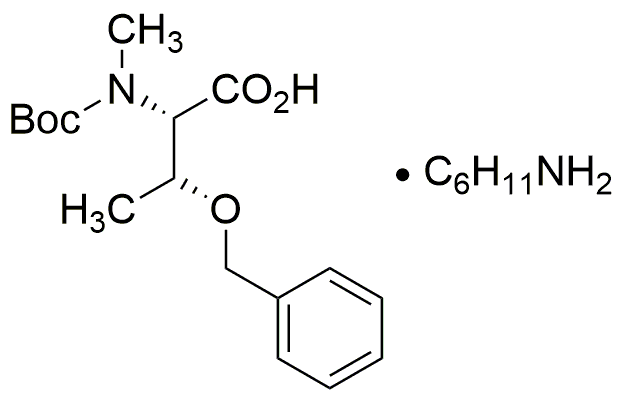Boc-N-methyl-O-benzyl-L-threonine cyclohexyl ammonium salt is widely utilized in research focused on:
- Peptide Synthesis: This compound serves as a protecting group in peptide synthesis, allowing chemists to selectively modify amino acids without affecting other functional groups. This is crucial in developing complex peptides for pharmaceuticals.
- Drug Development: Its unique structure aids in the design of new drugs, particularly in creating compounds with improved bioavailability and stability. This is especially beneficial in the pharmaceutical industry where efficacy is key.
- Biotechnology: In biotechnological applications, it is used to enhance the solubility of peptides and proteins, making it easier to study their properties and interactions in various biological systems.
- Research in Neuroscience: The compound can be utilized in studies related to neurotransmitter systems, helping researchers understand the role of specific amino acids in brain function and potential therapeutic targets for neurological disorders.
- Analytical Chemistry: It is also employed in analytical methods to separate and identify amino acids and peptides, providing researchers with reliable data for quality control in food and pharmaceutical products.
General Information
Properties
Safety and Regulations
Applications
Boc-N-methyl-O-benzyl-L-threonine cyclohexyl ammonium salt is widely utilized in research focused on:
- Peptide Synthesis: This compound serves as a protecting group in peptide synthesis, allowing chemists to selectively modify amino acids without affecting other functional groups. This is crucial in developing complex peptides for pharmaceuticals.
- Drug Development: Its unique structure aids in the design of new drugs, particularly in creating compounds with improved bioavailability and stability. This is especially beneficial in the pharmaceutical industry where efficacy is key.
- Biotechnology: In biotechnological applications, it is used to enhance the solubility of peptides and proteins, making it easier to study their properties and interactions in various biological systems.
- Research in Neuroscience: The compound can be utilized in studies related to neurotransmitter systems, helping researchers understand the role of specific amino acids in brain function and potential therapeutic targets for neurological disorders.
- Analytical Chemistry: It is also employed in analytical methods to separate and identify amino acids and peptides, providing researchers with reliable data for quality control in food and pharmaceutical products.
Documents
Safety Data Sheets (SDS)
The SDS provides comprehensive safety information on handling, storage, and disposal of the product.
Product Specification (PS)
The PS provides a comprehensive breakdown of the product’s properties, including chemical composition, physical state, purity, and storage requirements. It also details acceptable quality ranges and the product's intended applications.
Certificates of Analysis (COA)
Search for Certificates of Analysis (COA) by entering the products Lot Number. Lot and Batch Numbers can be found on a product’s label following the words ‘Lot’ or ‘Batch’.
Numéro de catalogue
Numéro de lot/série
Certificates Of Origin (COO)
This COO confirms the country where the product was manufactured, and also details the materials and components used in it and whether it is derived from natural, synthetic, or other specific sources. This certificate may be required for customs, trade, and regulatory compliance.
Numéro de catalogue
Numéro de lot/série
Safety Data Sheets (SDS)
The SDS provides comprehensive safety information on handling, storage, and disposal of the product.
DownloadProduct Specification (PS)
The PS provides a comprehensive breakdown of the product’s properties, including chemical composition, physical state, purity, and storage requirements. It also details acceptable quality ranges and the product's intended applications.
DownloadCertificates of Analysis (COA)
Search for Certificates of Analysis (COA) by entering the products Lot Number. Lot and Batch Numbers can be found on a product’s label following the words ‘Lot’ or ‘Batch’.
Numéro de catalogue
Numéro de lot/série
Certificates Of Origin (COO)
This COO confirms the country where the product was manufactured, and also details the materials and components used in it and whether it is derived from natural, synthetic, or other specific sources. This certificate may be required for customs, trade, and regulatory compliance.


